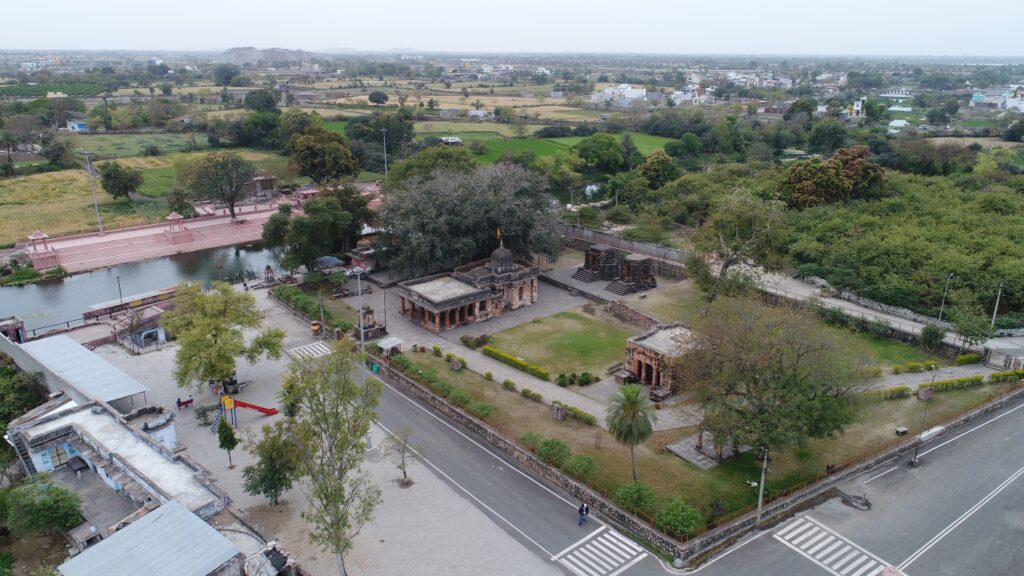
Chandrabhaga River Temple: A Historical and Spiritual Jewel
The Chandrabhaga River Temple, located near Jhalawar in Rajasthan, is a significant religious site with rich historical and cultural importance. This ancient temple is dedicated to the sacred Chandrabhaga River, known for its spiritual and ecological significance.
Location and Historical Context
- Location: Jhalawar, Rajasthan, India
- Historical Context: The Chandrabhaga River Temple is situated near the Chandrabhaga River, a historical water body with great religious significance. The region around Jhalawar is known for its historical temples and ancient ruins, making the Chandrabhaga River Temple an integral part of this heritage. The temple’s origins date back to medieval times, reflecting the architectural and spiritual traditions of that era.
Architectural and Design Features
1. Architectural Style
Ancient Hindu Temple Architecture: The temple showcases traditional Hindu temple architecture, characterized by its intricate carvings and robust construction. The design incorporates elements typical of temples built during the medieval period in Rajasthan.
Materials: Constructed primarily of sandstone, the temple features detailed carvings and sculptures. The use of sandstone enhances the temple’s durability and provides a distinctive appearance that blends with the surrounding landscape.
2. Main Shrine
Deity Representation: The main shrine of the Chandrabhaga River Temple is dedicated to the river goddess or deities associated with the Chandrabhaga River. The temple’s sanctum houses idols and images related to the river’s divine aspects, emphasizing its sacred nature.
Intricate Carvings: The temple’s walls and pillars are adorned with detailed carvings depicting various Hindu deities, mythological scenes, and geometric patterns. These carvings add to the temple’s spiritual ambiance and historical significance.
3. Temple Complex
Prayer Hall: The temple includes a spacious prayer hall where devotees gather for worship and rituals. The hall is designed to accommodate visitors and create a serene environment for reflection and prayer.
Surrounding Environment: The temple is situated near the Chandrabhaga River, enhancing its spiritual atmosphere. The surrounding natural environment adds to the temple’s tranquility and significance as a sacred site.
Cultural and Spiritual Significance
1. Spiritual Hub
Devotional Practices: The Chandrabhaga River Temple serves as a central place for worshiping and honoring the river goddess. Devotees visit the temple to offer prayers, seek blessings, and participate in rituals dedicated to the river’s divine aspects.
Festivals and Ceremonies: Festivals and ceremonies related to river worship and local traditions are celebrated at the temple. These events include special rituals, processions, and devotional activities that attract both local and visiting devotees.
2. Historical Importance
Cultural Heritage: The Chandrabhaga River Temple is an important part of Jhalawar’s cultural and religious heritage. Its historical and architectural significance reflects the region’s ancient religious practices and traditions.
Preservation of Tradition: The temple plays a vital role in preserving traditional Hindu customs and practices associated with river worship. It serves as a historical landmark that continues to engage the local community and visitors in religious and cultural activities.
Visiting Chandrabhaga River Temple
1. Planning Your Visit
Timings: The temple is generally open throughout the day, with specific timings for prayers and rituals. It is advisable to check the temple’s schedule, especially during festivals or special events, before planning your visit.
Entry Guidelines: Visitors are expected to dress modestly and follow the temple’s guidelines. Respectful behavior and adherence to local customs are important for maintaining the sanctity of the site.
Local Customs: Engaging in local customs and participating in rituals respectfully will enhance your experience and reflect appreciation for the temple’s spiritual significance.
2. Exploring the Temple Complex
Photography: Photography inside the temple may be restricted, particularly in the main shrine area. It is advisable to seek permission before taking any photographs and to follow the temple’s guidelines.
Nearby Attractions: While visiting the Chandrabhaga River Temple, consider exploring other attractions in Jhalawar such as the Jhalawar Fort, Gagron Fort, and local markets. These sites provide additional insights into the region’s history and cultural heritage.
Experience Sacred Serenity
The Chandrabhaga River Temple in Jhalawar offers a profound spiritual and historical experience, combining ancient architectural beauty with deep religious significance. Its tranquil environment, cultural importance, and commitment to traditional practices make it a significant destination for spiritual seekers and history enthusiasts alike.
Immerse yourself in the sacred atmosphere of Chandrabhaga River Temple, where divine reverence and historical grandeur converge. Let the temple’s serene setting and rich cultural traditions enhance your visit to Jhalawar and provide a deeper appreciation of Hindu spirituality and heritage.
